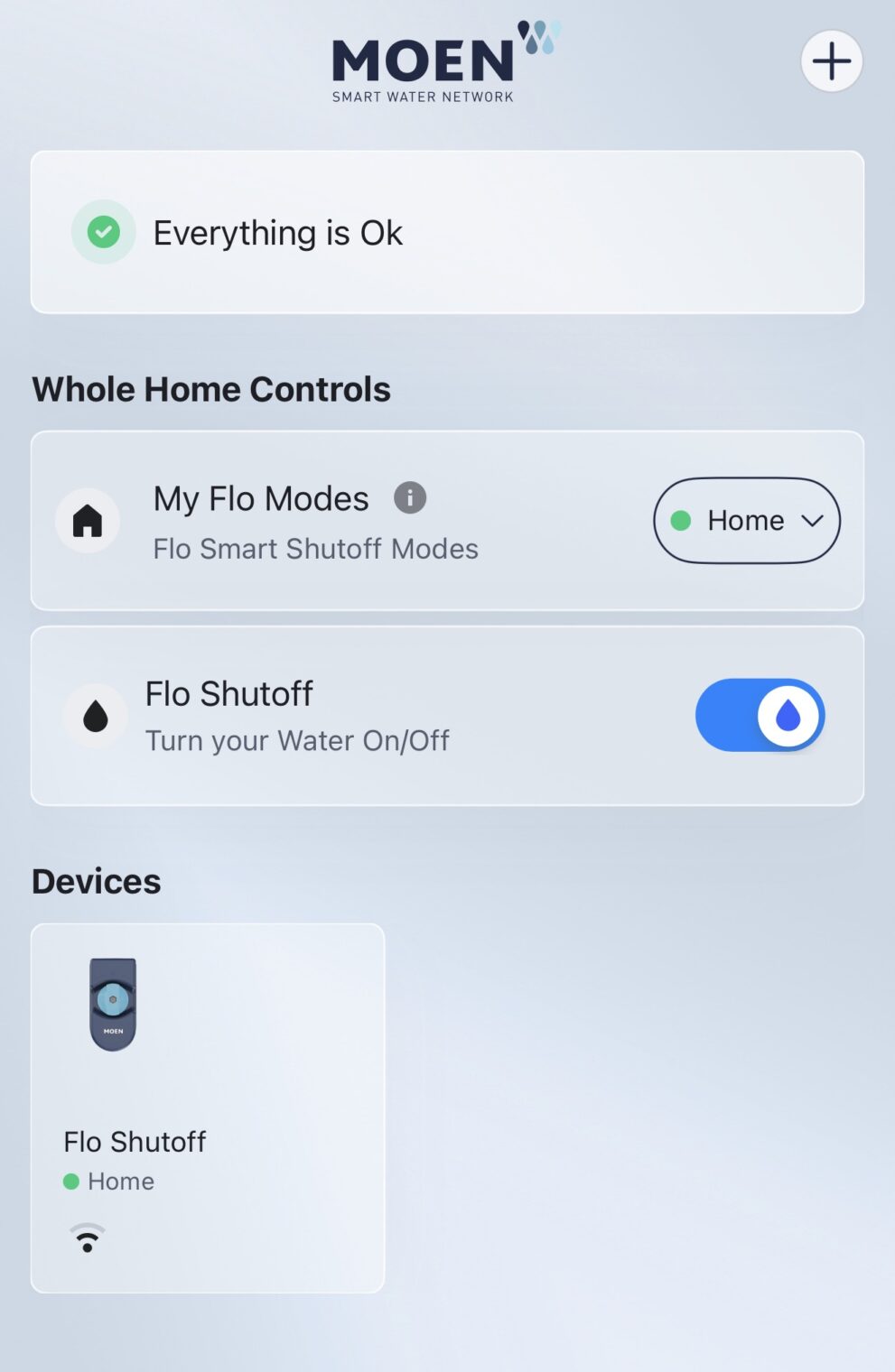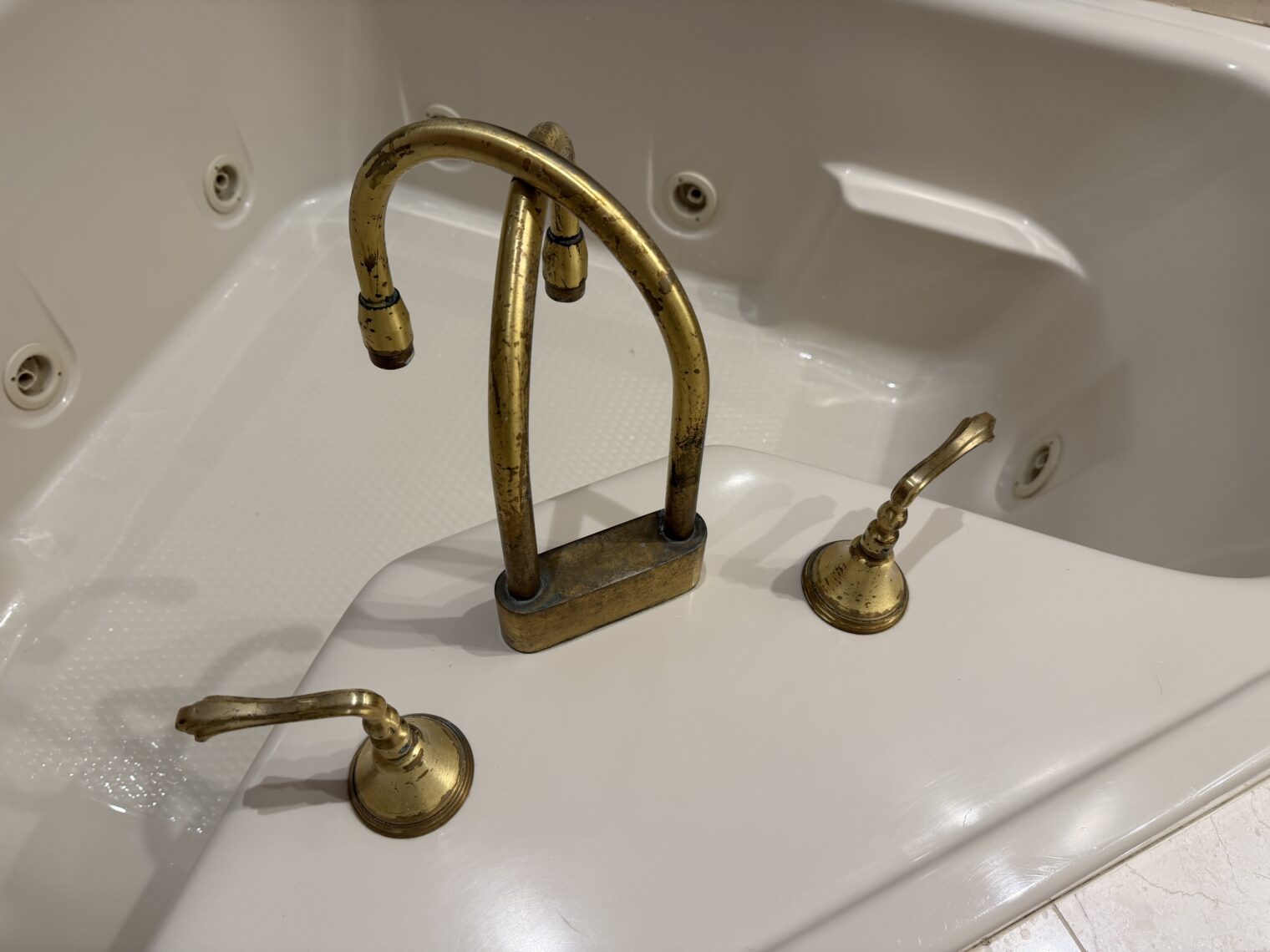Everyone in Florida prepares for the Category 5 hurricane that, generally, never shows up (e.g., Tampa hasn’t been hit badly by a hurricane for 100 years). Hardly anyone prepares for an internal water leak and quite a few of our neighbors have suffered severe home damage from, e.g., burst sink faucet supply lines. All of the houses in our neighborhood are about 23 years old and that’s apparently a great age for a massive water escape.
I debated and dithered between the Moen Flo and the Phyn Plus. The vulnerability of the Moen Flo is a mechanical impeller that reportedly fails after 1-3 years, but my friend decided that the Phyn Plus would impose more restriction on water pressure (maybe due to 3/4″ internal pipe where our supply is 1″?). Our plumber has a Flo so we decided to go with Moen (the evil Kohler empire rebrands Phyn Plus). The Phyn Plus makes some stronger claims for intelligence.
About one month after the Flo went in we had our first leak, a steadily dripping Roman tub faucet. Here’s an excerpt of the Flo’s recorded usage:
What’s remarkable about the above is that the AI Water Overlord decided that it was a perfectly normal usage pattern for a human to stand at a faucet for several days and pull out 0-0.01 gallons per minute. No alerts were issued. I did an AI support session with the app, which told me to go onto the web site and see if I could do a “MicroLeak” test there. The app wouldn’t let me do it maybe because it thought that a faucet was legitimately in use. In any case, the history showed a few MicroLeak tests passed with flying colors during an obvious and steady leak. Through all of this, the app displayed a “fat/dumb/happy” screen:
I eventually did call the Moen support number. The phone line was quickly answered by an American with no accent. He had no explanation for why the device hadn’t raised an alert, at least, and decided to escalate the question to Tier 2. Meanwhile, although I’d purchased a bundle of the device and three years of extended warranty and other support (assuming that the impeller will fail for us as it has for everyone else), the Web application showed me as not subscribed to “FloProtect” and kept trying to sell me “FloProtect”. The customer support agent confirmed that I actually WAS subscribed.
The leak was bad enough that if had happened while we were away for a few weeks it could have caused $50,000 of mold and other damage. Fortunately for us, however, it was leaking into a tub with a drain and we observed it with our own eyes.
The second fun part of this story was that I had previously asked a contractor to sort out the access panel situation for the Roman tub faucet and the shutoff valves. These were mostly tiled in so a plumber couldn’t service them. He converted two of the tiles to a magnetic mount. “Just cut the grout with a utility knife,” said the contractor, “and then maybe use a suction cup to get the tile out.” Of course, this was a huge challenge for me and I didn’t succeed without a trip to Home Depot to get a pro-grade suction cup grabber.
When I did get my unskilled paws on the 23-year-old shutoff valves I was able to turn them all the way to the right. This shut off the cold water to the tub, but the hot water still flowed out at a substantial rate and continued to drip (apparently, it was the hot water that was dripping). I torqued it down some more and finally got the pressure low enough that the dripping stopped with the faucet tap turned off. ChatGPT says that failure of old shutoff valves is common:
Most angle stops or multi-turn shutoff valves use a rubber washer or packing that seals against a brass seat. Over time, the rubber hardens, cracks, or disintegrates. When you turn the handle clockwise, the valve stem no longer presses tightly enough to fully stop flow — so you get a partial seal and reduced flow instead of a full shutoff.
So, as part of the joy of homeownership, in one day we had
- a leak detector that wouldn’t detect leaks
- an access panel that couldn’t be accessed
- a shutoff valve that wouldn’t shut off
I’ve been wanting to replace the tub filler for a couple of years but I can never wrap my head around how to find something that will fit the hole pattern that we have. Nobody has ever been able to figure out what kind of faucet this is. There is no manufacturer’s name or logo above or below the tub deck. It seems to all be high quality stuff, but there wouldn’t be any way to replace a cartridge or the trim (finish badly marred maybe by some previous owner’s cleaning attempt?) since we can’t figure out where it might have come from.
Maybe the goal should be to have it all done by National Fix a Leak Week (March 16-22, 2026 unless there is another government shutdown).
The actual leak:
Did the Flo ever shut off the water for any reason? Yes! The app had been told that we have a pool and that the pool lacks an auto-filler and it had seen multiple episodes of the pool being topped off by hose before. After I turned up the sensitivity following the failure to detect the above drip, the Flo shut off the water after about one hour/1,000 gallons. So I guess if we ever do have a leak in the house, the Flo will prevent more than 1,000 gallons from covering the floors?
Update: Mere hours after this post went live, the Tier 2 folks at Moen called me back. I learned that it does the MicroLeak test by shutting off the water in the middle of the night when, in theory, nobody would want to use it. Then it spends 1-4 minutes watching for a pressure drop that could be caused by a leak. This effect can be masked however, by traditional hot water heaters and their expansion tanks. It’s possible that the layout of our house and the expansion tank would prevent any Flo device from noticing a leak on the hot side (which I think is what we had). The Tier 2 folks watched the above video and said, however, that our Flo should have noticed that level of leakage. So they’re sending me new hardware, but with the caveat that it probably won’t fix the issue. I’m planning to test it by introducing a fake leak. At the same time, I learned that our plumber should probably have put in a new “consumer water shutoff” valve before the Flo. That would enable us to easily replace the Flo without having to go to the street shutoff.



That’s a high manetenance polishing job. What a lion would do to get rid of all these giant tubs & make a large man cave.
I think that fixture looks kinda kewl. Would make a good DIY project. Cleanup the brass as best as possible then coat with polyurethane. Shabby chic. Now that there is a working shutoff valve, pop out one of the cartridges under the handle and see if it is still made, could just be a Moen or something. Now onto turkey day where my trad/sysadmin wife makes me a old-fashioned turkey dinner from scratch, while I sit around and watch football and drink Bud, having fixed a dishwasher with a $5 gasket instead of buying a frighteningly expensive new one which is 10 times crappier.
I had several of these from before Moen bought the company and they were really in “beta testing” mode. The originals corroded in both Vero Beach, FL water and in Westport, CT water after a few years. Supposedly the corrosion problem has been addressed with the new models. The original ones saved us in Florida several times from genuine significant leaks, and in Connecticut, turned off the water when my son-in-law took an excessively long shower. I love that automatic valve!
That is the weirdest faucet I have ever seen! Whoever installed it must be the type who scratches their right ear with their left hand and their left ear with their right.
> Category 5 hurricane … Tampa hasn’t been hit badly by a hurricane for 100 years
Hurricane Milton was Category 5 and destroyed Tropicana Field to the point where the Rays had to move to Tampa proper for 2025. Now if you want to pick nits Tropicana Field is in Pinellas County while their temporary home is in Hillsborough County but to a non-Floridian that is a distinction without difference
St. Pete was hit by peak wind gusts of about 100-105 mph and the stadium there had its fabric roof torn, as you say (the roof was designed to be sacrificed in winds over 115 mph, but it was 34 years old against a design life of 25 years). Tampa was hit by peak gusts of about 90 mph. A modern house in Tampa must be built to handle 150 mph. A category 5 hurricane will have winds of 157 or more. The big worry for Tampa was a storm surge in Tampa Bay and that didn’t happen with Milton because the storm hit to the south of Tampa.
(Milton made landfall as a category 3 storm in Siesta Key, a barrier island off Sarasota. Only four hurricanes have made landfall in the U.S. as category 5 in the past 100 years. Hurricane Andrew (1992) is the most vividly remembered and had a huge impact on building practices in Florida.)
@paulg
Wikipedia classifies Milton as Category 5 but you are correct that it had decreased in intensity before it hit Florida on October 9. As an aside it looks like the roof is back on so the Rays will be moving back in 2026
https://x.com/TayVictoria8/status/1991585830415265982
Thanks for that link. My favorite part: “All of the repairs will cost almost $60 million. The city is legally obligated to pay for the repairs.” I would love to see a story about a professional sports team that pays its own bills. I guess it is better than the alternative: https://en.wikipedia.org/wiki/Gas_Plant_Stadium
“Gas Plant Stadium was a proposed indoor ballpark in St. Petersburg, Florida. If constructed, it would have served as the home of the Tampa Bay Rays of Major League Baseball. The construction cost was estimated to be $1.3 billion and the total cost to public was to be $1.5 billion.”
@lion
Florida Coast Strength Brasso
@philg
Our plumber recommended testing all the fixture shutoff valves every couple of years, and the main more frequently. A high-quality ball shutoff valve for the clothes washer is a good idea too. Turn off the main shutoff valve before you go on a trip. Buy a marine-grade fixture to replace the one on the spa tub.
Have we all learned how much better instrumentation combined with a human brain is than A.I.? Don’t use “A.I.” for anything, except for asking it advice on how to shut itself down. In retrospect, it would have made sense to have a big, red, hard-wired A.I. shutoff switch at Dave’s desk on the Discovery in the likely scenario of needing to shut down HAL-9000.
Main water shutoff replacement 101:
My water district is so nice that they send you a letter if you have a leak they detect. And then they send you a fine if you don’t fix it.